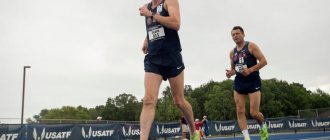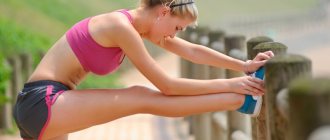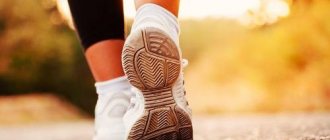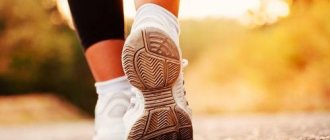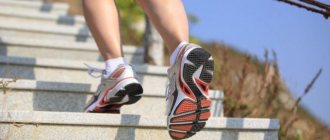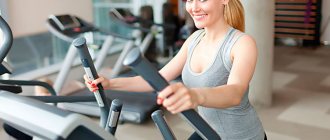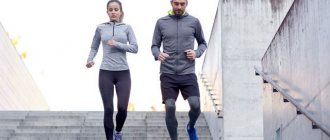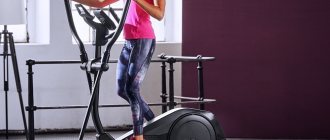Race walking will help you strengthen your body, become more resilient and create an ideal figure. Anyone can practice this sport. To do this you need to know the rules and techniques. Let's try to figure out how to practice race walking correctly, and what race walking should be like for beginners.
Type of sport: race walking
Many people who lead a healthy lifestyle know what race walking is. This is one of the Olympic sports, the peculiarity of which is the presence of constant support. This technique differs from the usual walking by a different pace, step length, and positioning of the legs. Race walking can be called health-improving, since it has a positive effect on the functioning of all organs and systems. By doing this sport, you can lose weight and strengthen your muscles.
Impact on stress
Everyone knows that in a stressful situation, playing sports helps relieve tension, relax, and calm down. Runners have a humorous answer to the phrase: “You can’t run away from problems.” - “You will run away, but not before the ninth kilometer.” Indeed, running is a great way to disconnect from negative thoughts, grievances and troubles. As they say, reboot. Walking promotes more leisurely comprehension, balanced making of the right decision and a calm look at the current situation from the outside.
How is race walking different from running?
Race walking differs from running in rules, technique and speed of movement. The main requirement for race walking is to step straight and rest on your heel. One leg is in contact with the surface, and the projection of the body is in a vertical position. Experienced athletes highlight the following differences between running and this sport:
- When running, the athlete lifts both legs at once between touches to the ground, and when walking, one leg makes the movement.
- When running, a low start is allowed, and during race walking - only a full start.
- The rules of race walking allow you to keep your leg straight when stepping, and bent when running.
- Running is many times faster than walking, but the latter sport is much more rhythmic.
- When running, the foot is subjected to six times the load, which can lead to serious damage. Race walking is safer.
What strengthens muscles better?
In large muscles, there are two types of fibers - white (responsible for endurance, strength) and red (volume and storage of glycogen). Both types of cells can be strengthened with exercise, but their growth rates differ markedly. Whites harden and grow very slowly, their growth can begin over several weeks, while reds gain volume quite quickly with proper nutrition and training.
Walking and running are different types of exercise in intensity. During walking, mainly the muscles of the lower leg are activated, while sprinting leads to the activation of almost all bundles of the human body. Both running and walking help strengthen muscles, but the speed of this process is different. On the other hand, the maximum effect is observed only when performing restrictive exercises with weights in the gym.
Rules of race walking
In essence, race walking is an alternation of steps performed in such a way that the athlete always has contact with the ground. It is important to follow the following rules:
- The forward leg must be fully extended from the very first contact with the ground until it passes the vertical.
- Walking technique is assessed by judges at the distance. Including the senior judge, there should be from six to nine people.
- Judges have the right to issue warnings to athletes using yellow paddles. On one side there is a wavy horizontal line, and on the other there are two segments connected at an angle of 150 degrees.
- The judge does not warn the walker more than once about one violation of the rules.
- Once a rule has been broken and the walker has received a warning, the referee must send a red card to the senior referee. An athlete may be disqualified if red cards from three different judges are sent to the chief judge.
- The senior judge has the right to disqualify an athlete on the final lap, or on the last hundred meters of the distance.
- For women, the distance should be 3.5 km in the arena, 10 km at the stadium and 20 km on the highway. For men - 3.5 km in the arena, 10, 20 km at the stadium and 20, 50 km on the highway.
- With each new step, the foot of the front foot must come into contact with the ground until the foot of the back foot leaves the ground.
- The supporting leg should not bend at the knee.
What should you choose?
Walking or running? What to choose, what to do?
You are an active person and want to keep your figure in good shape for as long as possible so that you feel great every day. The good news is that running and walking are great for achieving these goals. It all depends on your desire to keep yourself in shape and the characteristics of your health:
- Some people cannot run fast due to diseases of the cardiovascular system. The only option left is jogging or brisk walking.
- You should also not run if you have certain diseases of the musculoskeletal system, injuries to the joints and spine, or pregnancy.
- For those who are too lazy to run or have nothing to do, it is better to take walks. Walk to work if the weather permits. 5 km to work? It doesn’t matter, walking that distance in a day is just right! You can return back by car. Go out into nature on weekends, to parks, and walk in the fresh air. Go skiing in winter. You know that you can ski and you can run. Take advantage of it!
- For those who want to learn a new sport, there is race walking. Try it if interested.
- Have you noticed that grandparents with sticks in their hands have begun to appear in the parks? They walk and, as if on skis, hold Nordic walking poles in their hands. These are older people, everyone has some kind of diagnosis, but they still remain active, extending the years of their lives. Lead by example!
- Are you losing weight? For weight loss, running or walking are the main factors for weight loss. Running, of course, will give results faster. But walking is easier, we walk every day. And we don’t run that often. Therefore, perhaps walking will ultimately be more effective than running. After all, you can stop running. But you won’t give up walking completely. Develop the habit of taking a walk around your neighborhood before going to bed, for a duration of 30–40 minutes. During this time you will cover from 3 to 5 km, depending on your speed.
Walking has virtually no contraindications, but running is more complicated. You can run fast and slow. Jogging is prescribed even for older people, and fast running puts a lot of stress on the body, forcing it to work to the limit. For many people with various diseases, this can be simply harmful or even dangerous.
A diagnosis such as flat feet also interferes with running. But it doesn’t interfere with walking that much, although without special orthopedic insoles it is better to limit the extent of walking. The fact is that constant incorrect load with each step leads to deformation of the ankle, knee and hip joints. As a result, you may notice hallux valgus deformity and chronic inflammation of the joints. Take care of your feet!
Correct race walking technique
The sport of race walking has its own technique. The point is to optimally calculate the required load on the body. The average speed should be from six to ten kilometers per hour. The race walking technique has the following basic rules:
- Your arms should be bent at the elbows at an angle of no more than ninety degrees. They help the athlete move. If the hands are positioned correctly, this will make the walker's movement much easier.
- The athlete should keep his back straight. However, the body should be tilted slightly forward. The main key to success in walking is maintaining a balanced center of gravity.
- When walking, your heel should touch the ground first, and then your toe. Rolling is also important in race walking. It should be smooth and even across the foot.
- Legs must not be bent.
- You should move rhythmically and remember to breathe. Inhalation and exhalation should be deep and even.
- To build muscle mass in your legs, you can put a backpack with a small load on your back.
Knee angle
During running, the knees are bent at a greater angle than during walking, which increases the force of impact on the ground during running compared to that experienced during walking.
Increasing knee flexion also increases the force produced by the quadriceps (knee extensors). This is one reason why running is a more taxing activity on the knees and quadriceps than walking the same distance.
Walking shoes
For exercise to truly bring health benefits, it is important to choose the right running shoes for race walking:
- The shoes should fit well on the foot, but not be too tight. If the sneakers dangle on your feet, you may get injured as a result.
- The heel should be slightly raised.
- The ideal option is shoes with thick rubber soles.
- The upper of sports shoes should be made of breathable material. Leather or nylon mesh is a great solution.
- Shoes should be changed once every six months.
Training duration and nutrition
Regardless of whether you prefer to run or walk, you should set aside at least an hour for your workout. In the first half hour of training, glycogen reserves are burned, and only then the active process of fat burning begins. You should eat at least one and a half to two hours before the start of your workout. In addition, you should remember: if you want to lose weight, then you should refrain from eating for at least 1.5 hours after a run. Otherwise, the body, instead of continuing to burn its own fats, will use the nutrition that you gave it.
Race walking - benefits for the body
Before choosing this sport, many people are interested in the benefits of race walking. With its help you can:
- normalize blood pressure;
- reduce cholesterol;
- strengthen the skeletal system;
- improve insulin production;
- increase muscle mass;
- tone the body;
- carry out prevention of cardiovascular diseases;
- reduce body weight.
Endurance
How does running differ from walking in terms of endurance? So, from the point of view of energy consumption and weight loss, running is more effective. It will take longer to burn the same amount of calories by walking. People who burn the same amount of calories walking experience the same cardiovascular benefits: lower blood pressure, lower cholesterol. However, running improves endurance better than walking. Those who run regularly will be able to perform physical work for longer periods of time and develop greater endurance than those who only walk, albeit over significant distances.
Race walking - contraindications
Although the benefits of race walking are obvious, this sport still has contraindications. You cannot do race walking:
- during significant breaks in training;
- for injuries to the shoulder joints and arms;
- if race walking actively engages muscles;
- with flat feet;
- during hypertension;
- after abdominal surgery;
- with heart failure;
- if there is a network of infection and illness accompanied by fever;
- with anemia;
- in the presence of coronary insufficiency;
- during degenerative changes in the spine and joints.
Force
Running is a more intense exercise than walking. Not only do you use twice as much energy when running compared to walking, you also burn more calories when exercising for the same amount of time. This is the difference between race walking and running. For example, a 70-pound person can burn 800 calories in one hour by running, compared to only 300 calories by walking. Thus, the first type of exercise provides more benefits for burning fat in less time.
Also, compared to walking, running “explodes” muscles and increases the performance of fast and slow muscle fibers.
Race walking - records
In total, athletes set three records in the race walking discipline - two world and one Olympic.
- In August 2014, Frenchman Yoann Dini set a world record among men in Zurich with a result of 3 hours 32 minutes and 33 seconds.
- Two years earlier in London, the Olympic record was set by Sergei Kirdyapkin. His result is 3 hours 35 minutes 59 seconds.
- The world record for women was set in 2007 by Swedish athlete Monika Svensson. Her time is 4 hours 10 minutes and 59 seconds.
How can gadgets help?
The modern world cannot be imagined without a variety of gadgets. There are also ones for walking lovers:
- A posture corrector is a device that is attached to a T-shirt using a magnet. It does not hinder movement, does not rub and looks like a beautiful brooch. But if the body position changes - the person slouches, the device begins to vibrate. This is a very useful gadget, because correct posture is the key to walking effectively.
- Smart insoles – record the number of steps, mileage traveled, calories burned, and are also heated, which is especially important when walking in cold weather.
- Wireless headphones - allow you to listen to your favorite music during training without getting tangled in wires.
- Health sensor – shows heart rate, blood oxygen level and even stress level. Compact - easy to take with you.
- Smart watch - by installing the application, you can monitor your heart rate, number of steps taken, distance traveled, calories burned. In addition, the watch can remind you of exercises, and it can also be synchronized with your phone and receive information about calls and notifications.
Both running and walking have their pros and cons. It’s impossible to say unequivocally that walking is healthier than running; it’s all about physical fitness, health, age, amount of free time, goals, and so on. But the fact that movement is life is an indisputable fact .
Race walking - Olympic champions
Athletes from the USSR, Australia, China and Poland were able to achieve significant success in this sport. Robert Korzeniewski has the largest collection of Olympic gold medals. He became the winner in the 50 and 20 kilometer distances. Famous race walking champions:
- Hartwig Gauder (GDR).
- Andrey Perlov (USSR).
- Nathan Dix (Australia).
- Robert Korzeniewski (Poland).
Among women, the following Olympic champions can be noted:
- Elena Nikolaeva (Russia).
- Olga Kaniskina (Russia).
- Elena Lashmanova (Russia).
